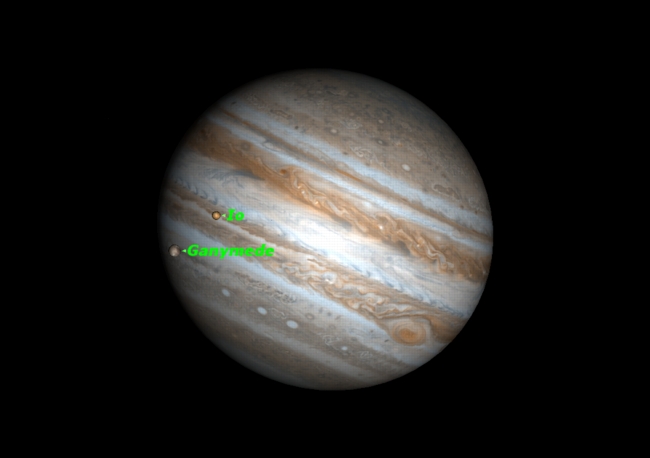Jupiter's Moons to Perform Double Shadow Play on Monday

A remarkable series of events involving two of Jupiter's most well-known moons will occur on Monday, Jan. 24, but you'll need a telescope to see them.
Four hundred years ago, famed astronomer Galileo Galilei first turned his telescope onto Jupiter and discovered that the giant planet was accompanied by four large moons – Callisto, Europa, Ganymede and the volcanic Io.
These satellites orbited Jupiter like a miniature solar system and gave Galileo the proof he needed that our solar system's planets revolved around the sun in exactly the same way as Jupiter’s moons circle their parent planet.
On Monday night, amateur astronomers with telescopes and clear weather will have a chance to witness a sight similar to those seen by Galileo as Ganymede and Io cross in front of Jupiter as seen from Earth.
This illustration of Jupiter and its moons depicts how the planet and satellites will appear at 7:15 p.m. EST/4:15 p.m. PST from North America. Notice that the Great Red Spot will just be ending its own transit of the disk of Jupiter at that time, an added bonus.
Jupiter's moon shadow play
As Jupiter's moons revolve around the planet, they go through a series of events known as the phenomena of Jupiter's moons. The moons pass in front of Jupiter (known as "transits"), behind Jupiter (occultations), their shadows cross the planet's face (shadow transits), and the moons are immersed in Jupiter's own giant shadow (eclipses). [Infographic: Inside Planet Jupiter]
Get the Space.com Newsletter
Breaking space news, the latest updates on rocket launches, skywatching events and more!
All these events are carefully predicted in advance, and are watched with interest by amateur astronomers equipped with telescopes large enough to see them.
These predictions are accurate enough that they can be thrown off by the speed of light, so much so that Danish astronomer Ole Rømer used them to measure the speed of light for the first time in 1676.
Usually these events happen in isolation or in pairs, but occasionally a whole series can occur in a single night. That's what will happen on Monday evening over North America.
Here's what you'll see
Because Jupiter is nearing the sun, it sets fairly early, so observers in any one area will see only part of the show. Between the time when the sky becomes dark enough to observe Jupiter and Jupiter gets too low in the sky to be observed.
Because so many events will happen in so short a time, there should be plenty for every observer with a telescope to see. A telescope is essential to observe these events.
Jupiter's moons themselves are easily seen even with binoculars, but when they get close to Jupiter, they require more optical aid. The shadows of the moons on the planet require an instrument with at least a 3-inch aperture. To see the moons themselves, a bit more is required.
When the moons begin to pass in front of Jupiter, all first appear as bright specks because Jupiter's limb is darker than the center of the disk. As they pass across the face of Jupiter, Io and Europa tend to blend in with the background clouds so that they vanish in all but the largest telescopes.
Ganymede and Callisto, having darker surfaces, change from bright spots on the limb to dusky grey spots in front of Jupiter's cloud belts, and are visible with a 6-inch telescope.
Only Io and Ganymede will perform during Monday's Jupiter moon shadow play, but the views should be impressive for skywatchers with clear, dark skies.
Here are the play-by-play predictions for Monday night, in both Eastern and Pacific Standard Time. Observers elsewhere in North America can figure out their local times from these.
- 6:51 p.m. EST/3:51 p.m. PST Io will begin a transit in front of Jupiter’s disk
- 7:04 p.m. EST/4:04 p.m. PST Ganymede will also begin a transit of Jupiter
- 7:58 p.m. EST/4:58 p.m. PST Io's shadow will begin to cross Jupiter’s face
- 9:05 p.m. EST/6:05 p.m. PST Io will end its transit
- 10:07 p.m. EST/7:07 p.m. PST Ganymede will complete its transit
- 10:10 p.m. EST/7:10 p.m. PST Io's shadow will end its transit
- 11:45 p.m. EST/8:45 p.m. PST Ganymede's shadow will begin to transit Jupiter
Observers on the eastern U.S. coast will miss the end of these events because Jupiter will have slipped below the horizon. Observers on the West Coast will miss the beginning of these events because of too much illumination in the sky at that time.
But no matter on which coast you find yourself, everyone should be able to catch some of these amazing Jupiter moon crossings.
This article was provided to SPACE.com by Starry Night Education, the leader in space science curriculum solutions.
Join our Space Forums to keep talking space on the latest missions, night sky and more! And if you have a news tip, correction or comment, let us know at: community@space.com.

Geoff Gaherty was Space.com's Night Sky columnist and in partnership with Starry Night software and a dedicated amateur astronomer who sought to share the wonders of the night sky with the world. Based in Canada, Geoff studied mathematics and physics at McGill University and earned a Ph.D. in anthropology from the University of Toronto, all while pursuing a passion for the night sky and serving as an astronomy communicator. He credited a partial solar eclipse observed in 1946 (at age 5) and his 1957 sighting of the Comet Arend-Roland as a teenager for sparking his interest in amateur astronomy. In 2008, Geoff won the Chant Medal from the Royal Astronomical Society of Canada, an award given to a Canadian amateur astronomer in recognition of their lifetime achievements. Sadly, Geoff passed away July 7, 2016 due to complications from a kidney transplant, but his legacy continues at Starry Night.









